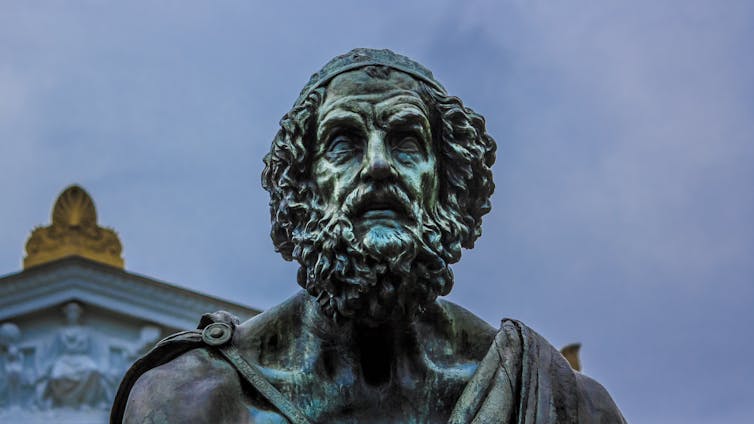
On February 2 2022, Ulysses turns 100, James Joyce would have turned 140, and I will turn 30-something.
To celebrate this tripartite birthday I am popping to the chemist to collect some eye drops. Then I’m heading to the Bodleian Library in Oxford to view one of the first editions of Ulysses. I won’t read it. I won’t even venture past its covers. I am interested in seeing the exact shade of blue that Joyce specified for the book’s wrappers. He was so particular about this aesthetic feature that he got his painter friend, Myron Nutting, to mix up the precise tint.
This is where the eye drops come in. I have a chronic condition that can make my eyes sore and my vision blurry. And I want to ensure that I can see Ulysses clearly, to properly assess the blueness of its cover. The irony is that Joyce’s eyesight was far worse than mine. He experienced severe eye pain, underwent multiple ocular surgeries and, at times, could barely see at all. Why, then, was he so obsessed with his book being such a specific hue of blue?
Ulysses Blue
Joyce’s biographer, Richard Ellmann, tells us that the cover of Ulysses was meant to match the blue of the Greek flag, to suggest the myth of ancient Greece and Homer. We know from his letters that Joyce sent a Greek flag to Nutting for him to colour-match. So, he was aiming for “Greek” blue.
We also know that Homer was a huge influence on Joyce. The structure of Ulysses parallels the structure of Homer’s Odyssey. So, it makes sense for Joyce to honour his literary hero through a subtle, yet exceedingly specific, decorative detail. But I think there’s more to it.

I am on a research odyssey to discover the impetus and symbolism behind “Ulysses blue”. I will go to the Bodleian with my eyes wide open, ready to let my visual experience of the famous blue book dictate my avenue of research.
But, given Joyce’s impaired vision, perhaps this isn’t the best approach. To understand Joyce’s perspective, I must shrug off my “ocularcentrism”.
Blindness in Joyce’s texts
In her thoughtful new book, There Plant Eyes: A Personal and Cultural History of Blindness, writer and educator M. Leona Godin devotes several pages to her interactions with Ulysses. She discusses the “blind stripling” character who taps his way through Dublin, and through Ulysses, using his “slender cane”.
Godin praises Joyce’s ability to capture the musicality of the tapping cane and articulates the complexity of Joyce’s relationship with blindness: “Even if Joyce felt some kinship with the blind stripling, he was still a sight-oriented person who might think […] of the blind as ‘they’.”
Joyce would have loved Godin’s book, as he appears to have had a keen interest in blindness memoirs and advice guides written by blind people, for blind people (and their supporters). Scholars have largely glossed over Joyce’s references to blindness in his composition notebook. But I’m delving deeper to get to grips with Joyce’s thoughts on visual impairment.
It is fascinating to read Joyce’s depiction of the blind stripling in Ulysses, alongside one of the blindness books mentioned in his notes: Les Aveugles par un Aveugle (The Blind as Seen through Blind Eyes) (1899), by Maurice de la Sizeranne.
As I outlined in a public lecture last Bloomsday, there are several similarities, in terms of content and focus, between the two books.
The observations de la Sizeranne makes about his fellow blind man parallel those made by Ulysses’ protagonist Bloom about the blind stripling. Both Bloom and de la Sizeranne discuss the intriguing relationship between colour perception and touch, in blind experience, and suggest an additional blind sense: a “kind of sense of volume” involving the “nerves of the face” or the “forehead”. In reflecting blind experience onto his blind readers, de la Sizeranne - to borrow a phrase used in Ulysses - urges us to “see ourselves as others see us”.
In Joyce’s notes, the name of a hitherto unidentified “Dr Staub” is scrawled next to the title of de la Sizeranne’s book. Staub was believed to be one of Joyce’s eye doctors. However, I have discovered that he is, in fact, Dr Theodor Staub, the blind founder of the Swiss Library for the Blind.
It is unclear why Staub’s name appears next to Les Aveugles par un Aveugle. Whatever the precise connection, in jotting down Staub’s name Joyce, at the very least, demonstrated a desire to engage with the blind community and with books for the blind.
Blind, blue bards
In his final book, Finnegans Wake (1939), Joyce alludes to Ulysses. He depicts Shem, a partially sighted writer, reading a “usylessly unreadable Blue Book” in a “glaucous den”.
In ancient Greek, the word “glaucous” refers to blueish-green or blueish-grey. It’s also the root word of “glaucoma”. Joyce suffered from glaucoma, and, in one of his letters, he writes that Homer “went blind from glaucoma according to one of my doctors”.

So, perhaps “Ulysses blue” is a homage to glaucoma (via ancient Greece and Homer). By insisting on Greek-flag blue, was Joyce seeking, through rather associative means, to insert himself into a canon of blind writers?
There is no definite answer to this question. But, by recognising Joyce as a disabled writer with a genuine interest in articulating a wide range of bodily and sensory experiences, we open up new possibilities for accessing Ulysses in its centenary year. We should feel empowered to read Joyce’s blue book through our eyes, ears, and fingers.
Cleo Hanaway-Oakley does not work for, consult, own shares in or receive funding from any company or organisation that would benefit from this article, and has disclosed no relevant affiliations beyond their academic appointment.
This article was originally published on The Conversation. Read the original article.







